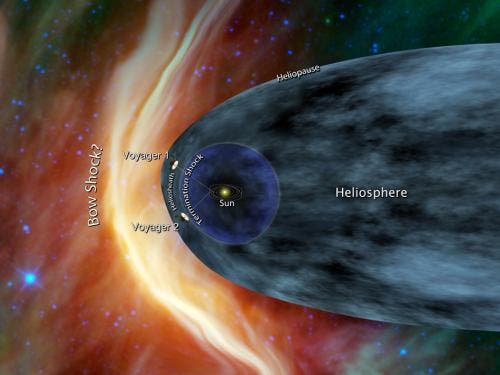It’s remarkably impressive how a spacecraft built and launched in the late 70’s is not only still functional, but well on its way of becoming the first man-made object to leave our solar system. After 35 years, new data shows that this plucky probe may soon cross the undulating boundary between the edge of our solar system and interstellar space.

Artist impression of the Voyager-1 spacecraft, and its partner, Voyager-2, as they’re approaching the edge of the Sun’s protective bubble, separating them from interstellar flight. (c) NASA/JPL-Caltech
The boundary of the solar system has been settled by scientists as the place where the solar wind fizzles out completely – this called the heliopause. Currently, Voyager-1 is still in the heliosheath where the sun’s solar wind is significantly slowed by the pressure of interstellar gas, but not quite minimal yet. Tantalizing signs now have it that Voyager I, now some 11 billion miles from home, is right near this cosmic milestone for humanity. Voyager-1′s sister probe, Voyager-2, is currently lagging behind about 2 billion miles
“It’s not that clear because there’s no signpost telling you that you’re now leaving the solar system, but the evidence is mounting that we’re getting really close,” says Arik Posner, a Voyager program scientist at NASA’s headquarters in Washington, D.C.
Voyager’s initial mission in the late 70’s was that of taking first close-up pictures of Jupiter, Saturn, Uranus and Neptune, but apparently it went on going, and it has been for decades now. NASA engineers at the time were apparently invested with some sort of scientific foresight, when they decided to equip the spacecraft with a nuclear power source. Each Voyager is powered by three large radioisotope thermoelectric generators (RTGs), each containing 24 pressed plutonium-238 oxide spheres. The heat released by the decay of the radioactive material is converted into electricity using an array of thermocouples, initially granting around 470 watts of power. The power output of the RTGs does decline over time, though, but the RTGs will continue to support some of its operations through about 2025, more than enough to exit the solar system and transmit data back of what really lies beyond.
“When the Voyagers launched in 1977, the space age was all of 20 years old,” said Mr. Stone. “Many of us on the team dreamed of reaching interstellar space, but we really had no way of knowing how long a journey it would be — or if these two vehicles that we invested so much time and energy in would operate long enough to reach it.”
via NPR









